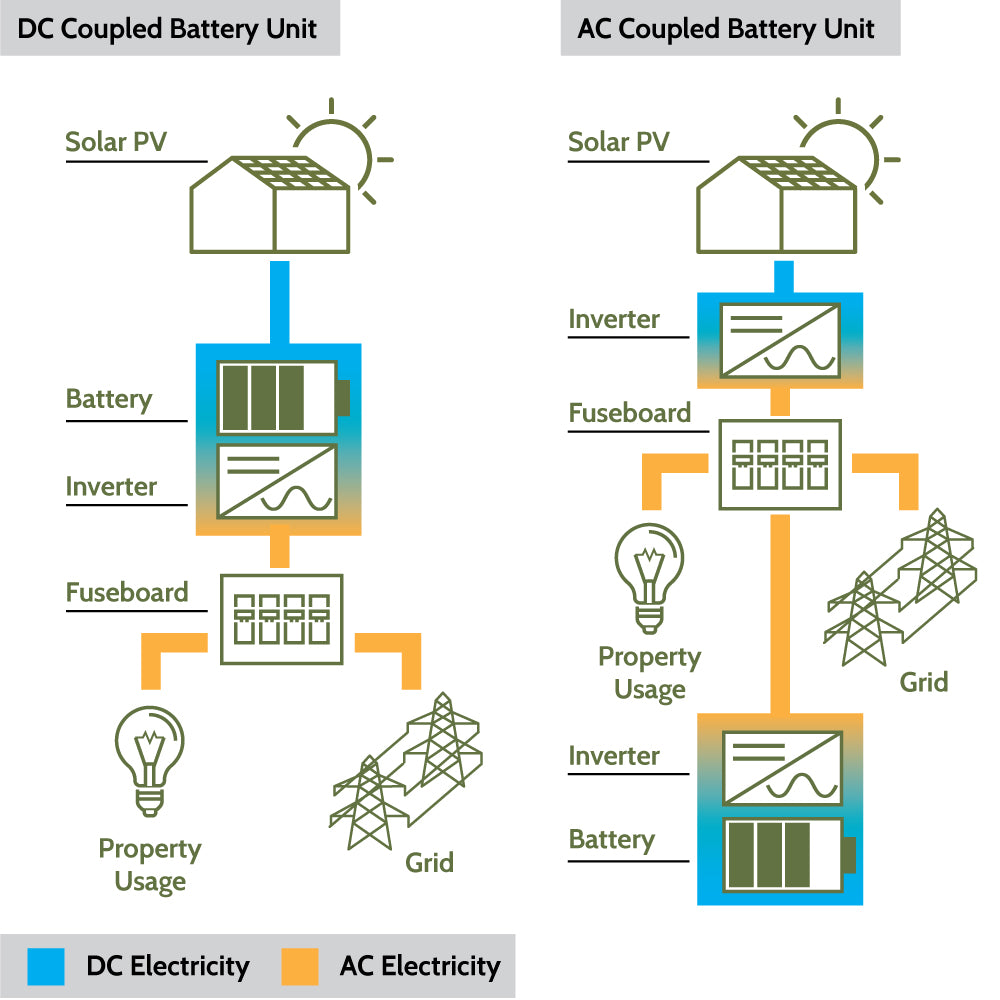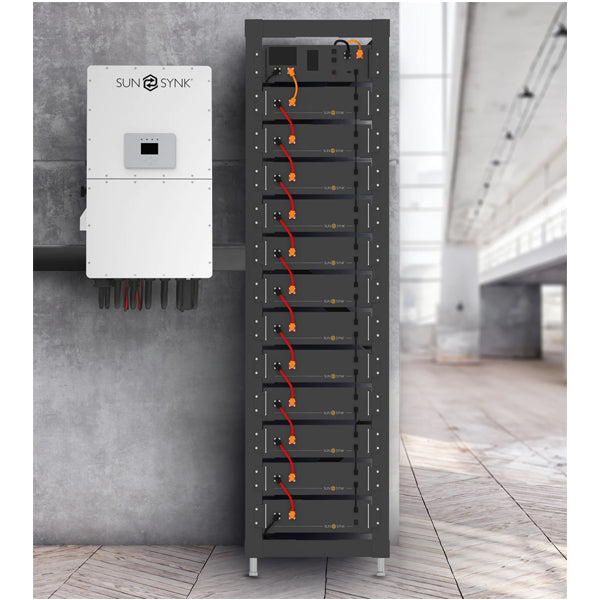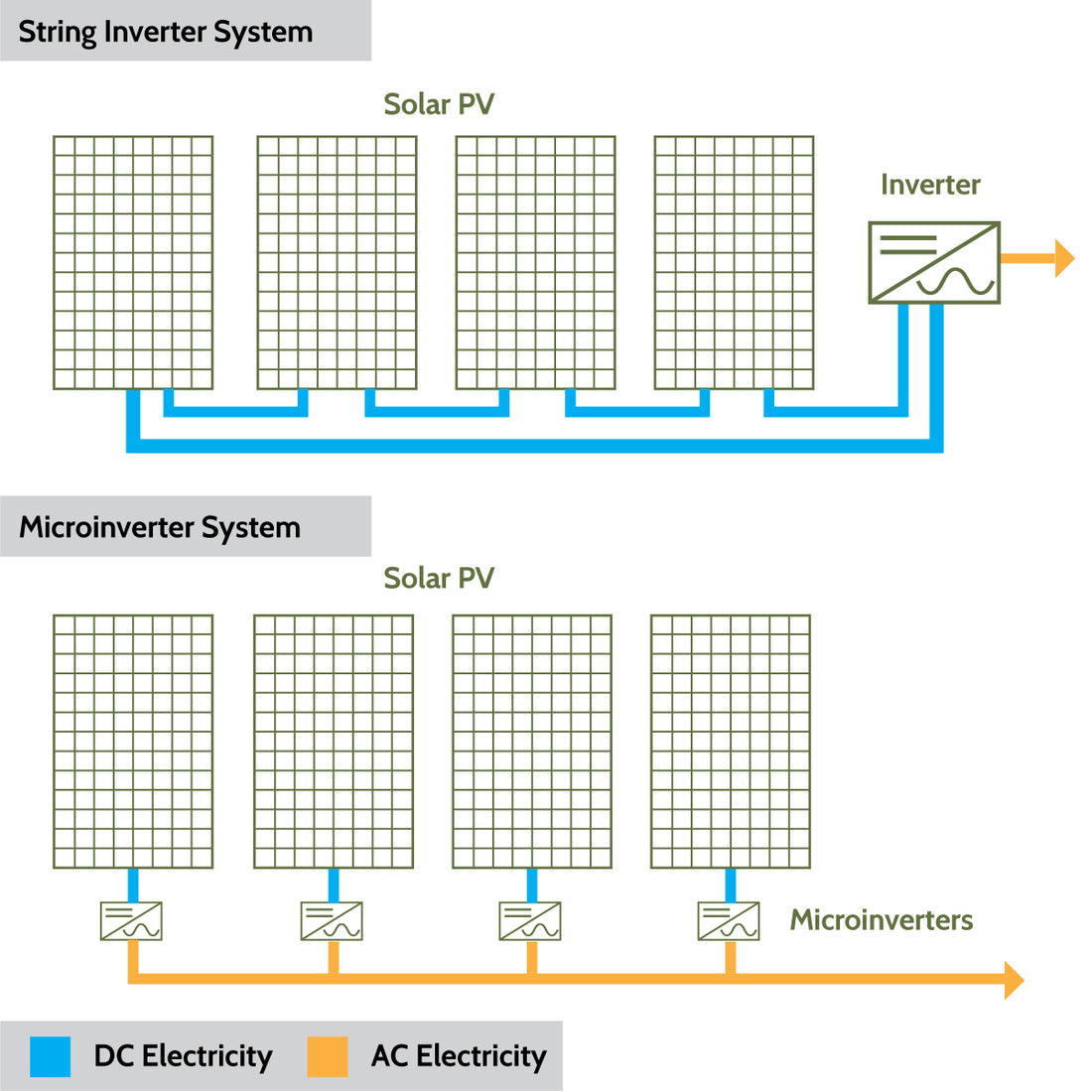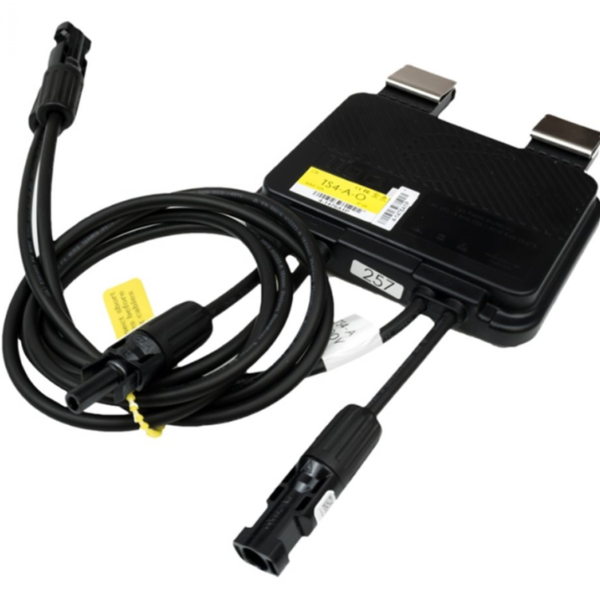Expert Help & Advice
Your guide to power inverters
Power inverters are the heart of any solar panel system, converting the electricity generated by your panels into usable energy for your property. Choosing the right inverter and understanding how it works are essential steps in planning your solar system. In this guide, you’ll find helpful information on inverter types, installation, cost and compatibility.

-
What is a power inverter?
A power inverter is an electrical device that converts the direct current (DC) electricity generated by your solar panels into alternating current (AC) electricity.
AC electricity is what most household appliances, lighting and devices use, and it’s also the type of electricity fed into the grid. Without an inverter, the energy generated by your solar panels can’t be used in your home or fed back into the grid.
Key benefits of power inverters
Do I need a power inverter for my solar panel system?
Yes, a power inverter is essential for any solar panel system. While solar panels generate electricity, the inverter makes it usable. Without it, your panels cannot power appliances or send energy back to the grid.
If you plan to integrate solar battery storage, your inverter also plays a key role in managing the energy flow between your panels, battery and property.
What size inverter do I need?
Usually, the size of your inverter will match the capacity of your solar panel system so it can handle the energy produced. For example, a 4kW solar panel system typically requires a 4kW inverter. If you will need more power further down the line, you can expand your system as your needs grow.
Oversizing or undersizing
Oversizing allows your system to handle additional panels but can increase initial costs.
Undersizing reduces upfront costs but risks energy loss if the panels generate more electricity than the inverter can handle.
If you plan to add more panels later, choose an inverter with a higher capacity. If you’re unsure, an installer can assess your property’s energy needs and recommend the best option. At HDM Solar Wholesale, we work with a network of MCS-accredited installers who ensure your system is installed to the highest standards.
How much are solar inverters?
The cost of solar inverters can vary depending on the type of inverter, its capacity, and whether it is designed for single-phase or three-phase systems. Whether you’re looking for a cost-effective solution for a small residential system or a high-capacity inverter for a commercial installation, we stock a range of inverters to suit all needs and budgets.

-
Inverters types and design
There are four main types of solar inverters: string inverters, microinverters, hybrid inverters and AC-coupled inverters.
What is a string inverter?
A string inverter is connected to the “string” or “series” of solar panels and converts the entire series’ DC output into AC output.
String inverters are best suited for systems with uniform sunlight conditions (e.g., no shading or obstructions). Since you only need one for the entire system, they are typically simpler to install, easier to maintain and more cost-effective. However, if one panel’s performance drops (e.g., due to shading or dirt), it affects the output of the entire string.
What is a microinverter?
Installed on each panel, microinverters convert DC to AC electricity at the individual panel level. They are best used on systems with complex layouts, where panels face different directions or are affected by shading.
Microinverters maximise individual panel output, provide detailed monitoring and offer better performance in shaded areas but usually come at a higher upfront cost. More components mean potentially more maintenance, and because microinverters are located close to the solar panel system, they need to be resistant to humidity and heat.

-
String inverters vs microinverters
This diagram demonstrates how string inverter systems differ from microinverter systems.

-
Power optimisers
Power optimisers are used to improve the output of a string inverter. They ‘fix’ the voltage of the generated DC electricity of each panel before it is sent to the central string inverter, which increases the total power output of the system.Shop our range of power optimisers
They don’t increase the power output as much as microinverters, but they cost less to purchase and install, so can be considered a good compromise for homeowners looking to improve their system for a smaller cost.
What is a hybrid inverter?
A hybrid inverter combines a standard inverter with a battery inverter, allowing your solar panel system to store excess energy in batteries for later use.
Unlike traditional inverters, hybrid models manage the flow of energy between your solar panels, battery and property. They are ideal for systems where energy storage is planned from the start or may be added later.
How do hybrid inverters work?
Hybrid inverters work by converting the DC electricity generated by solar panels into AC electricity for immediate use in homes or businesses. They also manage batteries, directing excess solar energy generated during the day and storing it so it can be used later or to supply power during power outages.
Benefits of hybrid inverters
- Store excess energy during the day for use at night
- Reduce dependency on the grid
- Lower electricity bills
- Combine two devices (inverter and battery inverter) into one unit
- Prepare your system for energy storage without needing additional upgrades
- Allow systems to operate during grid outages
Do hybrid inverters interact with the grid?
As well as handling solar and battery power, hybrid inverters interact with the grid. They can export surplus energy to the grid when production exceeds demand or draw power from the grid when solar and battery resources are insufficient.
This dynamic allows the hybrid inverter to prioritise energy sources intelligently, using solar energy first, followed by battery storage, and finally grid power as a last resort.
How does an AC-coupled inverter work?
AC-coupled inverters allow you to add battery storage to an existing system that does not already have a hybrid inverter.
DC electricity, generated by the solar panels, passes through the inverter, converting it to AC electricity. The AC electricity can be used in the home, exported to the grid or stored in the battery.
Key takeaways
- For simpler, cost-effective systems in consistent sunlight, string inverters are ideal
- For more complex systems, or where shading is an issue, microinverters offer superior performance.
- Hybrid inverters combine a standard inverter with a battery inverter, they’re great if you’re looking to store energy to use at night or during a power outage.
- If you’re looking to store energy, and already have a solar PV system, AC-coupled inverters are a good choice.
Phases of inverters: single-phase vs three-phase
Single-phase inverters
A single-phase inverter converts direct current (DC) electricity from a source, such as solar panels or batteries, into alternating current (AC) electricity with a single-phase output.
This type of inverter is common in most residential properties. They connect to a single-phase power supply, so they’re ideal for smaller systems with lower energy requirements.
How does a single-phase inverter work?
A single-phase inverter works using a technique called pulse-width modulation (PWM). This process involves breaking the DC power from the solar panels into a series of pulses. The inverter regulates the width of these pulses to control the amount of power sent to the grid.
Single-phase inverters typically have two main stages:
- DC-DC conversion: The high-voltage DC power from the solar panels is converted into lower-voltage DC power suitable for further processing.
- DC-AC inversion: The lower-voltage DC power is then transformed into AC power, making it compatible with the electrical grid or powering homes and businesses.
Three-phase inverters
Used in larger homes and commercial properties with three-phase grid connections, three-phase inverters distribute electricity across three phases, reducing load and increasing efficiency.
They’re essential for systems with higher energy output, such as large-scale installations or properties with heavy equipment.
How do three-phase inverters work?
- DC-DC conversion: The high-voltage DC power from the solar panels is converted into a stable and optimised DC voltage. This stage often includes maximum power point tracking (MPPT) to maximise the energy extracted from the solar panels.
- DC-AC inversion: The stabilised DC power is converted into AC power across three phases. The inverter generates three alternating waveforms that are 120 degrees out of phase, creating a balanced three-phase output suitable for commercial or industrial systems or feeding into the grid.
How is an inverter installed?
Installing an inverter involves careful planning to ensure compliance with electrical standards, so we recommend that they are always installed by qualified professionals.
Installation process:
- Location: Inverters are usually installed near the distribution board (fuse box) in a garage, utility room, or external wall. Placement is important; the inverter needs to be easily accessible for maintenance and away from direct sunlight to avoid overheating.
- Mounting: Inverters can be wall-mounted or ground-mounted. Brackets will be used to secure the inverter to a wall or structure, or a secure mounting base if ground-mounted.
- Wiring: The inverter is connected to your solar panels, grid connection and battery (if included). The solar panel strings are connected to the inverter’s DC input terminals using connectors (e.g., MC4 connectors) to ensure proper polarity. A DC isolator switch is installed between the panels and the inverter for safety. The AC output of the inverter is then connected to the grid or loaded through the main distribution board, with an AC isolator switch between the inverter and the grid/load to allow safe disconnection.
- Testing: Once installed, the system is grounded and then tested to ensure proper functioning, and monitoring software (if applicable) is configured to track energy production and system performance.
-

String inverter
-

Microinverter
Which inverter should you choose?
The power inverter you choose will have a significant impact on the performance and efficiency of your solar system. To make the best decision, consider:
- Your system size: Match the inverter’s capacity to the energy output of your panels.
- Type of installation: Decide between string inverters for simpler systems and microinverters for more complex setups.
- Future plans: Opt for a hybrid inverter if you plan to add battery storage later.
- Property requirements: Determine whether single-phase or three-phase inverters suit your grid connection.
With the right inverter, you can maximise the performance of your solar system and enjoy reliable, renewable energy for years to come. If you’re certain about adding batteries now or in the future, hybrid inverters are a more efficient and future-proof solution. If you’re focused on cost-saving for a non-battery system, a standard inverter can still be a great choice, with the option to retrofit for energy storage down the line.








